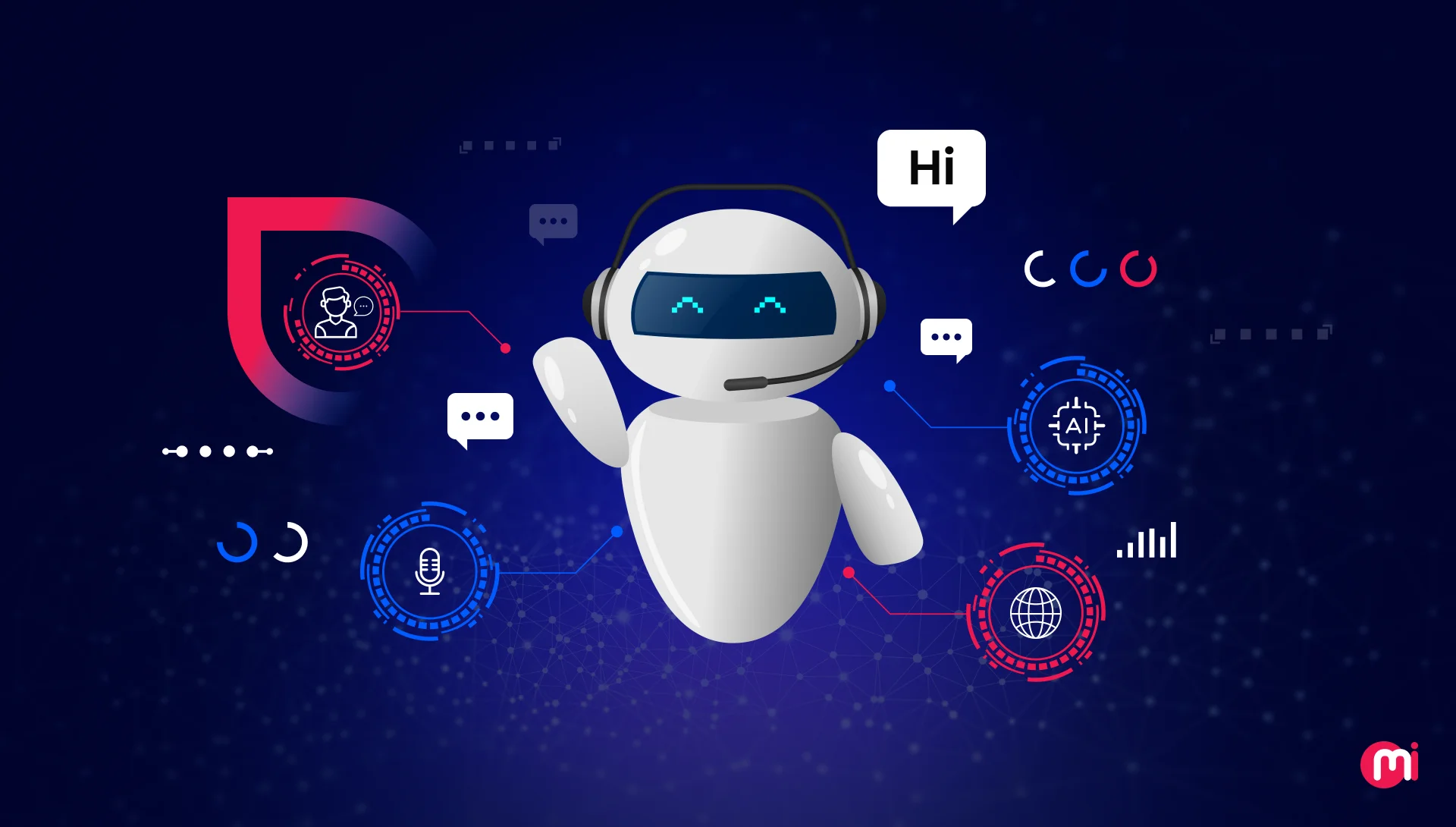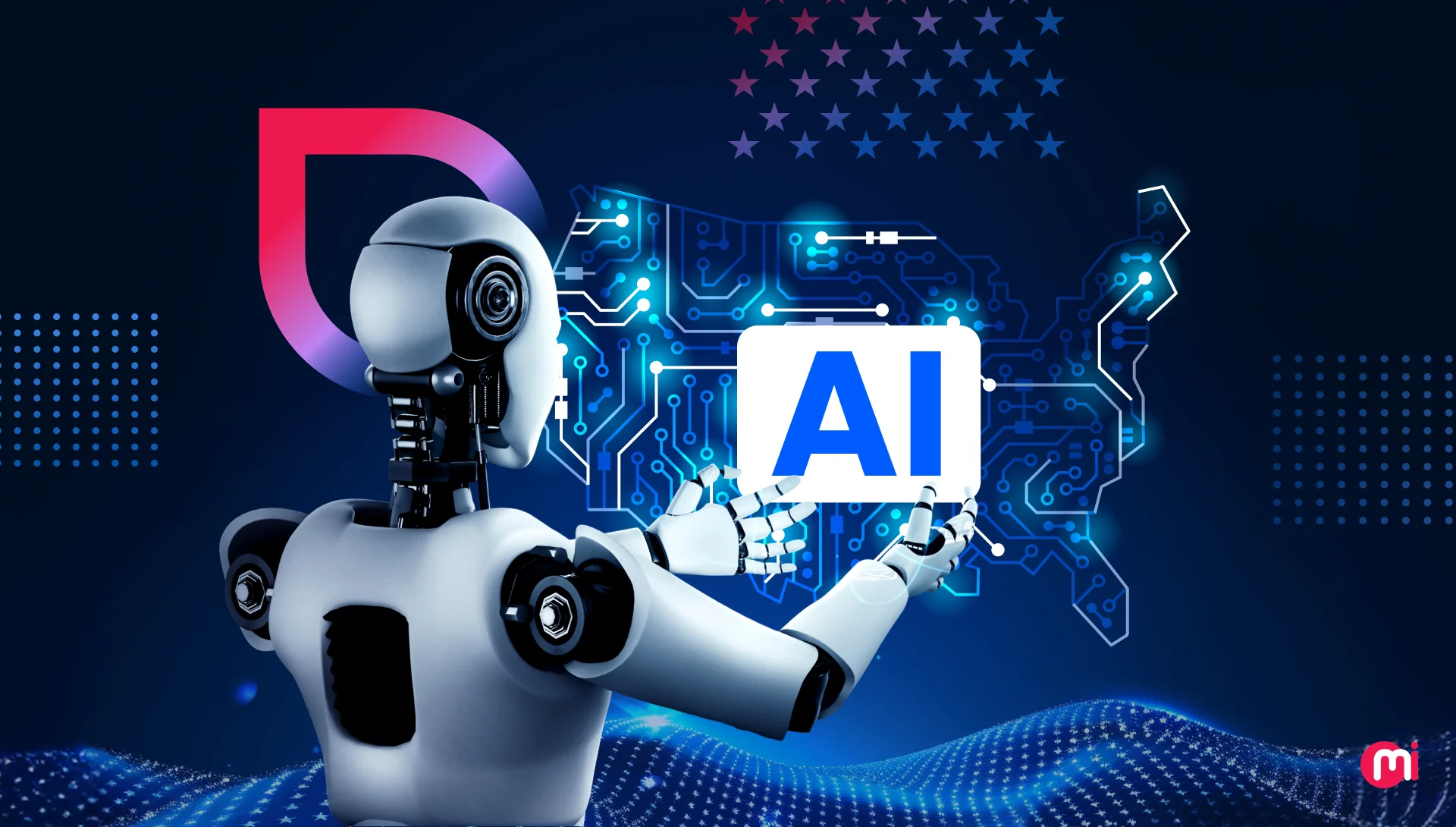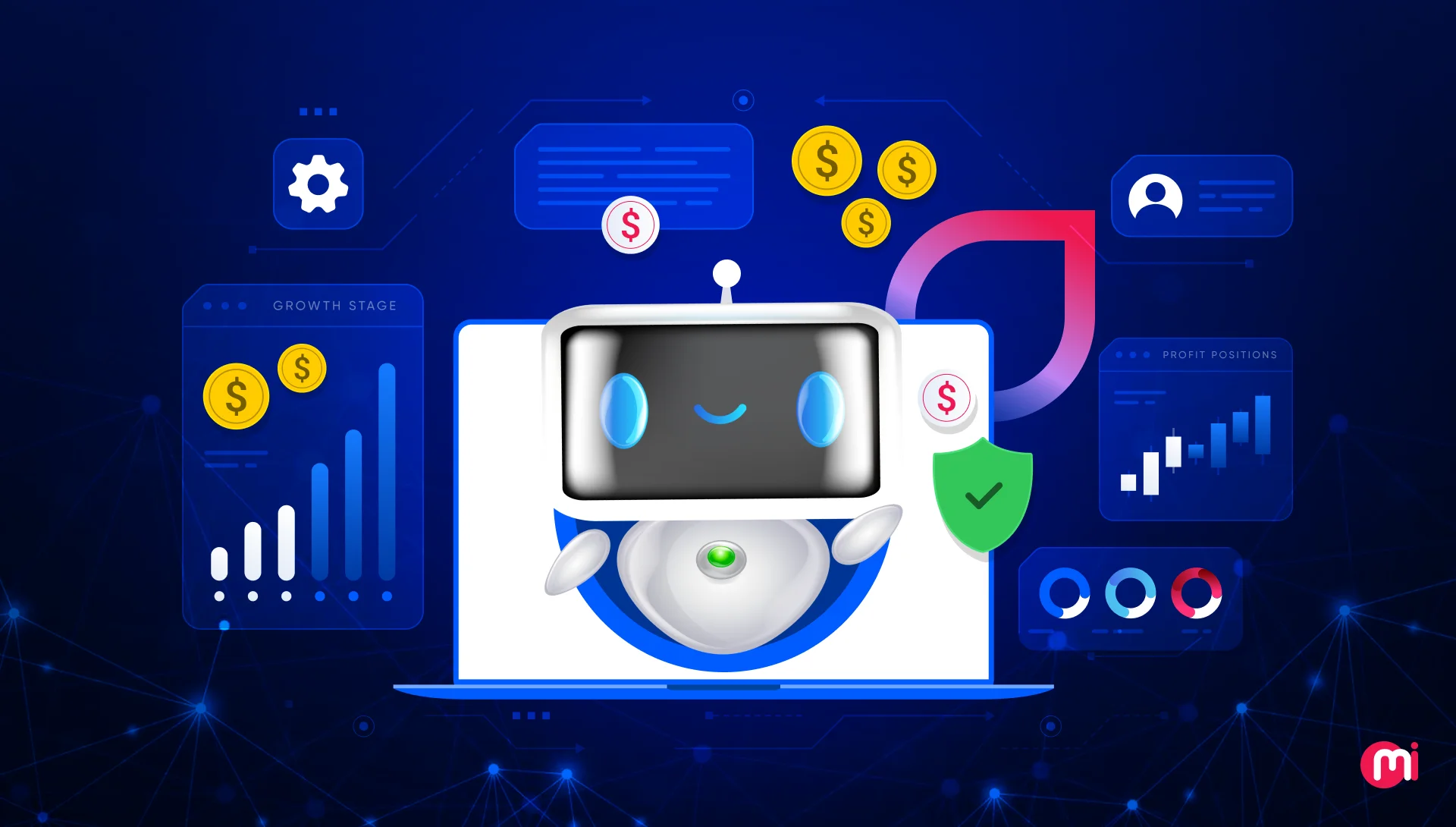The Role of AI in Customer Service: Benefits, Use Cases, and Strategies
- AI/ML
- September 26, 2025
With more than 50%, use cases of AI in customer service have the fairest share, which is more than cybersecurity and digital assistants. Artificial Intelligence (AI) is reshaping businesses’ interactions with customers, offering instant answers, smarter support systems, and predictive solutions.
From virtual assistants to personalized recommendations, AI-powered customer service improves efficiency, customer satisfaction, and scalability. Businesses using AI say it has improved their ability to scale customer service operations and the company’s growth. For example, Bradesco improved customer experience by 85%, and SquareDash increased accessibility by 99%.

The above-mentioned are just a glance; however, this blog explains AI customer service in detail. It includes use cases, benefits, real-life examples, and how to implement AI in customer service. Through this blog, you’ll have a clear understanding of AI-powered customer service before you hire AI developers to leverage its benefits.
Key Takeaways:
- AI in customer service boosts efficiency, personalization, and scalability while improving customer satisfaction.
- Traditional customer service struggles with speed and personalization, but AI delivers instant, tailored support.
- AI unlocks 24/7 support, efficiency, and personalization, giving your business the edge to scale customer experience.
- Real-world examples from companies like SquareDash and Bradesco, prove AI delivers measurable business impact.
- Successful AI adoption requires a clear strategy, quality data, and balanced automation with a human touch.
What is AI in Customer Service?
AI in customer service is about using artificial intelligence to automate, streamline, and enhance interactions between businesses and customers. It involves using various tools and applications to respond to customer inquiries around the clock.
Common AI applications in customer service include chatbots, virtual assistants, automated email responses, and sentiment analysis tools. These technologies employ machine learning algorithms and natural language processing (NLP) to gain understanding and respond to customer queries accurately and in real time.
AI-powered customer service helps businesses achieve faster response times with tailored customer interactions and resolve issues quickly.
Stats of the Uses of AI in Customer Services
AI has various use cases, like AI in supply chain management, AI for digital assistants, AI in inventory management, and more, however, customer service has topped the ranking. 56% of business owners use AI for customer service operations. See the image below to ensure an easy understanding:
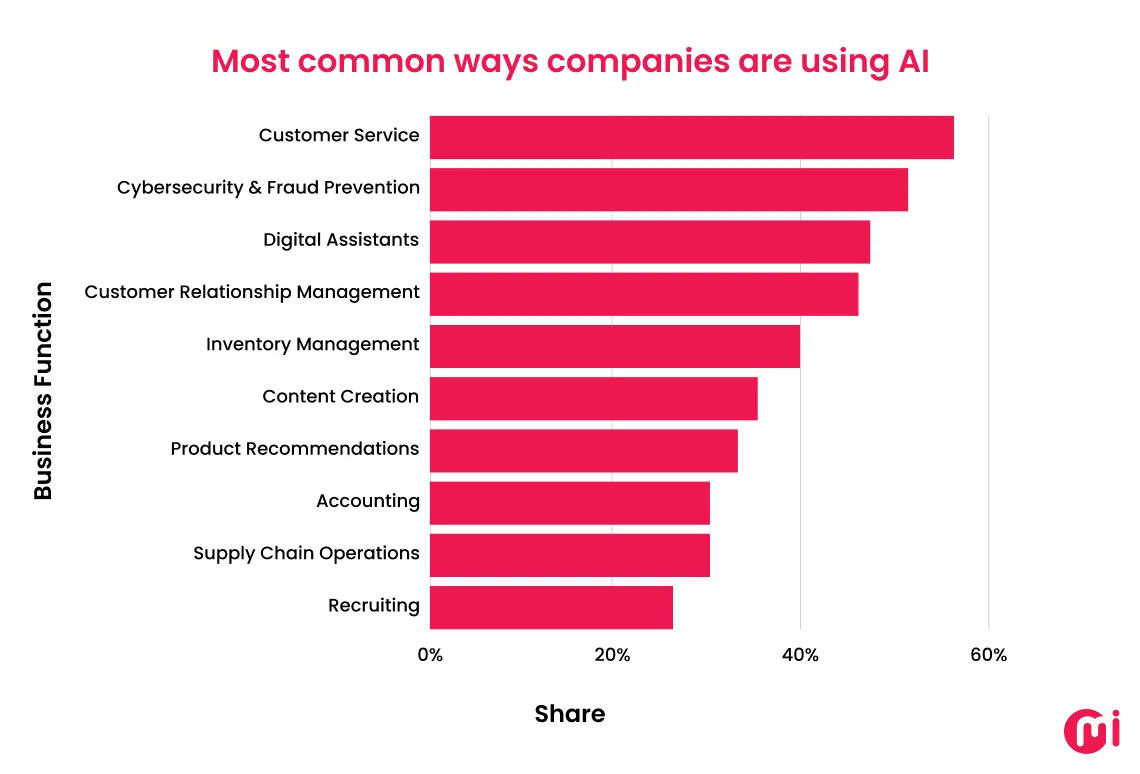
The Role of AI in Customer Service
There’s a significant role of AI in customer service. It improves efficiency, leading to enhanced customer satisfaction. Since today’s customers expect real-time, tailored support and are less tolerant of disjointed or delayed experiences, AI becomes a must-have. AI-powered customer service enables faster responses, 24/7 support, personalized recommendations, and automated task handling.
By analyzing customer behavior and predicting their needs, artificial intelligence in customer service provides a strategic advantage, enhances the overall customer experience, and builds loyalty. It results in reduced costs and frees up human agents to handle complex issues, fostering a culture of efficient customer service with optimized profitability.
Use Cases of AI in Customer Service with Examples
There are many use cases of AI in customer service, including predictive customer support, instant response, virtual customer assistance, and many more. Here’s how they are transforming business across industries:
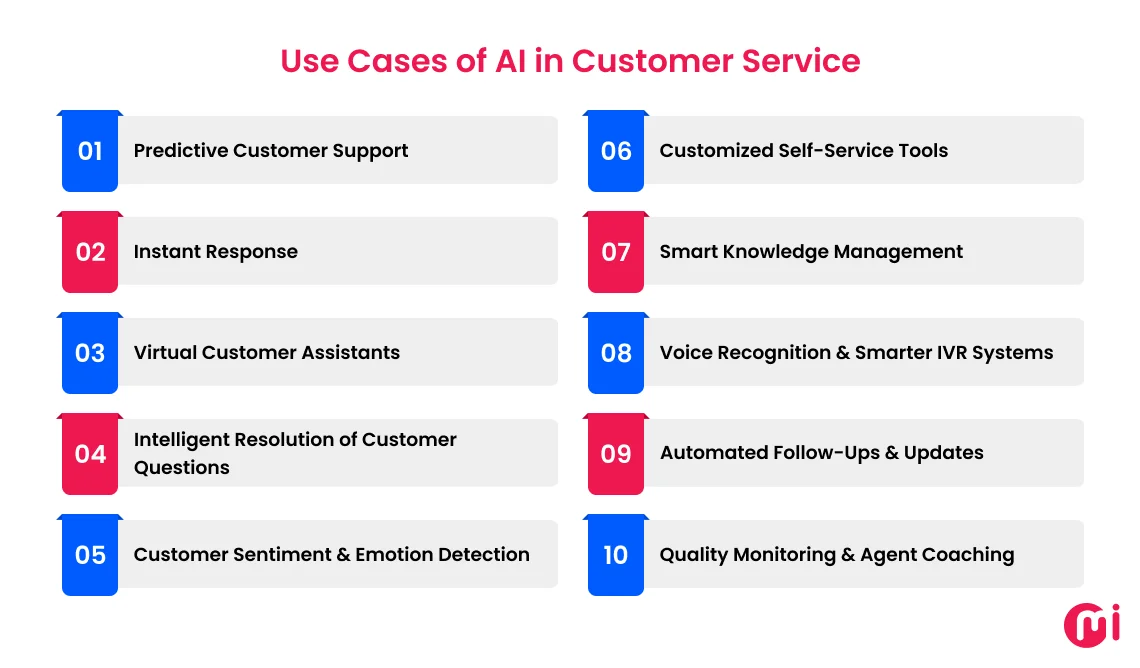
1. Predictive Customer Support
Artificial intelligence in customer service spots when something is not right, including the cases when there’s an unusual account activity or a service about to lapse. By predicting the potential issue, AI helps customers before they even realize it.
AI uses analytics like past interactions, purchase history, usage patterns, and even device logs to look at customers’ past behavior and compare it to real-time patterns. It helps figure out what you may need to do next, for example, a subscription renewal reminder or help with a product.
Example: A telecom company uses AI to detect unusual patterns in internet connectivity. Before the customer even notices the outage, the system automatically creates a support ticket, informs the user, and suggests appropriate fixes.
Impact: Reduced downtime, improved customer satisfaction, and fewer inbound complaints.
2. Instant Response
Remember the last time you asked a question on a website and got the answer right away. That’s usually a chatbot. AI-powered chatbots offer immediate answers and assistance to common customer queries and FAQs, regardless of time.
An AI chatbots development company builds chatbots using natural language processing (NLP) and machine learning (ML), enabling them to understand and respond to users’ queries in human language. The NLP enables chatbots to learn from historical customer interactions and improve over time.
Example: An eCommerce brand deploys an AI chatbot that instantly handles order status inquiries, returns, or refund requests. It helps the brand free up human agents for complex issues.
Impact: Faster resolution times, lower support costs, and better scalability during peak demand (like holiday sales).
3. Virtual Customer Assistants (VCAs)
Virtual customer assistants are more advanced compared to basic chatbots that handle multi-turn conversations and even complete transactions. VCAs are often used in e-commerce. They’re found in mobile apps or smart devices that make use of conversational AI, which combines NLP and ML, creating human-like interactions.
AI agents are capable of handling more complex tasks, such as placing orders, resolving account issues, or offering product advice, through both text and voice.
Example: A bank’s VCA helps customers open new accounts, apply for loans, or reset passwords without human involvement.
Impact: Reduced call center load, faster query resolution, and improved accessibility.
4. Intelligent Resolution of Customer Questions
AI customer service automatically assesses query type, sentiment, and urgency, then routes it to the best-suited agent. While machine learning analyzes historical behaviours and outcomes, predictive analytics makes use of data to forecast the urgency and immediately refer it to the right people.
Example: An insurance company’s AI system directs high-priority claims to senior adjusters while routine billing questions go to automated support.
Impact: Reduced wait times, higher first-call resolution, and better use of human expertise.
5. Customer Sentiment & Emotion Detection
AI-enabled tools in customer service can read the tone and emotion in a customer’s message. These tools use sentiment analysis technology and evaluate language cues, aiming to understand how someone feels.
AI monitors tone of voice, word choice, or chat inputs to detect frustration, satisfaction, or confusion in real time. It helps them know whether the customer is angry, frustrated, or happy, enabling teams to respond faster to unhappy customers and wisely handle tough conversations with appropriate care.
Example: A call center system flags when a customer sounds angry and alerts supervisors to intervene or offer escalation.
Impact: It results in proactive recovery of bad experiences and improved customer loyalty.
6. Customized Self-Service Tools
AI personalizes knowledge, base, articles, FAQs, and troubleshooting steps based on the customer’s profile and history. Instead of getting a customer digging through an endless loop of help pages or FAQs, AI-enabled customer services advise the exact solution.
These solutions are guides, videos, or solutions based on what a customer searched for, viewed, or purchased. The very system relies on recommendation engines, an algorithm engine, trained to recognize and advise relevant resources.
Example: A software development company offers AI-powered troubleshooting tailored to the user’s operating system and past product issues.
Impact: This results in higher self-service success rates and reduced support tickets, improving user experience and the brand’s credibility.
7. Smart Knowledge Management
AI in customer service scans, tags, and organizes a large amount of support content. It creates a wider knowledge base to support both support agents and customers, finding the right answers in no time.
AI uses machine learning to learn and determine the most relevant article based on the customer’s query. There are some companies that use generative AI, enabling them to instantly create tailored help content or summaries.
Example: An airline company uses AI to automatically add new flight change policies into its support documentation after updates.
Impact: Always up-to-date resources and faster agent onboarding. It fosters faster updates, fewer errors, consistent information across all touchpoints, and less burden on human support teams.
8. Voice Recognition and Smarter IVR Systems
AI-enabled voice recognition enables automated phone systems, like IVR (Interactive Voice Response), to understand spoken language. Instead of getting forced through endless “press 1, press 2” cycles, IVR systems enable users to explain their issue naturally.
Perfectly combined with conversational AI, the system fosters an intuitive, less frustrating phone assistance experience, boosting the support center’s efficiency and credibility.
Example: A retail chain’s IVR lets customers say, “Track my order,” instead of choosing from multiple service categories.
Impact: Shorter calls, fewer transfers, and exceptional customer experience, skyrocketing the brand’s credibility and business growth.
9. Automated Follow-Ups And Updates
AI in customer service ensures customers stay informed with personalized updates and reminders via SMS, email, or app notifications. When a support interaction ends, Robotic Process Automation (RPA) sends follow-up emails, summaries, case updates, or satisfaction surveys, without needing human input.
RPA automates rule-based repetitive tasks, aiming to speed up customer service operations, freeing up agents to resolve issues that are more complex and necessary.
Example: A healthcare service provider uses AI to send appointment reminders, prescription refill alerts, and follow-up satisfaction surveys.
Impact: It results in improved engagement, fewer missed appointments, and higher retention.
10. Quality Monitoring and Agent Coaching
AI in customer service reviews support interactions (voice, chat, email) and provide performance feedback and training suggestions for agents. By reviewing support interactions, AI flags potential issues, such as policy violations or unsatisfactory assistance to customers.
Using real-time analytics and machine learning, AI in customer service helps managers train agents and fix problems as they occur.
Example: An AI-powered contact center flags when an agent interrupts too often or misses empathy cues, then recommends coaching modules.
Impact: Consistent service quality, faster training cycles, and empowered agents.
Read Also: RAG as a Service.
What are the Benefits of AI in Customer Service?
The benefits of using AI in customer service includes 24/7 availability, faster response times, providing more accurate information, personalized responses, better emotional engagement, cost efficiency and many more. Here’s the detailed analysis of the top benefits of AI-powered customer service you should know:
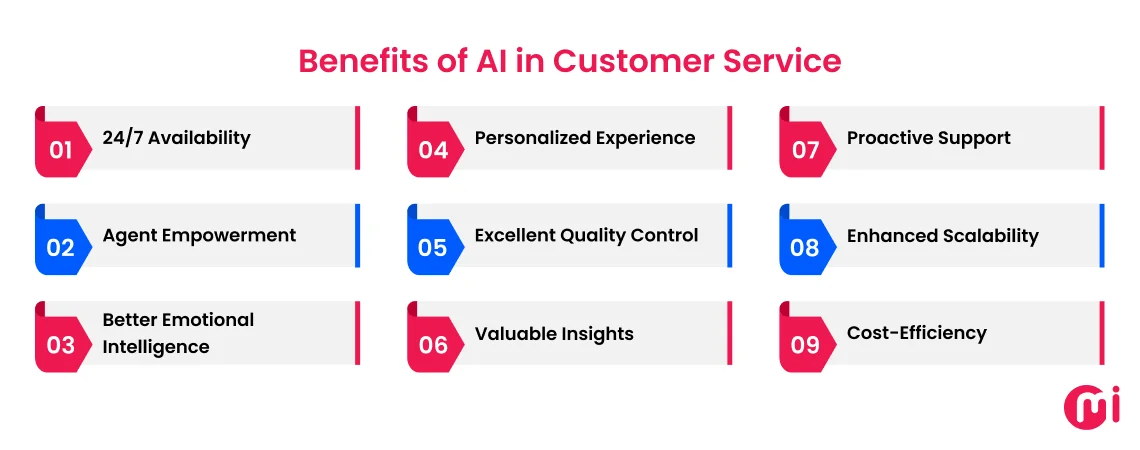
24/7 Availability
AI-powered chatbots and virtual assistants enable businesses to be available around the clock. It reduces waiting time and improves customer satisfaction through on-time assistance, irrespective of whether it’s a website, mobile app, or traditional call center.
Agent Empowerment
AI handles simple and repetitive queries and automates routine tasks. It also provides agents with real-time insights and suggests next steps during conversations. This way, it saves human agents significant time to focus on more complex and high-value issues. This reduces burnout and boosts productivity.
Better Emotional Intelligence
With sentiment and emotion detection, AI tends to sense customer frustration or satisfaction in real time. With emotional intelligence, AI in customer service helps agents respond with empathy and more effective solutions.
Personalized Experience
AI analyzes data like customers’ history, preferences, and behavior to know and tailor solutions to their needs. Using these data, AI delivers tailored recommendations, support, and offers, making every interaction feel unique.
Excellent Quality Control
AI in customer service frequently monitors interactions, flags errors, and ensures consistent service. This, in turn, improves training and keeps the overall support experience excellent.
Valuable Insights
By analyzing large volumes of interactions, AI uncovers trends, customers’ pain points, and their needs. Organizations utilize these data to enhance their products and services.
Proactive Support
AI predicts issues before customers even reach out, for example, alerting users about service outages or billing anomalies. This is what creates a smoother experience.
Enhanced Scalability
AI-enabled systems in customer service can handle thousands of simultaneous queries without delays. This makes it convenient for businesses to scale support during peak demands without needing to hire extra staff.
Cost-Efficiency
From data analytics to personalized service offerings and assistance, AI makes customer service cost-effective. It reduces manual workload and improves efficiency, thereby lowering operational costs while delivering faster and more consistent customer support.
Real-Life Examples of Companies Using AI in Customer Service
SquareDash and Bradesco are among the top examples of using AI in customer service you should know. Here’s why they implemented AI in customer service and how this initiative helped them ease the hassle and optimize customer experience:
1. SquareDash
SquareDash is an insurance claim management firm that helps companies and individuals obtain insurance claims as early as possible. Mindinventory, an AI/ML development company, helped SquareDash implement AI, enabling it to deliver unique experiences to its customers.
SquareDash claims that the AI implementation resulted in:
- 99% increase in accessibility
- 95% improvement in document processing
- 90% reduced error rates
- 50% reduction in claim processing time
2. Bradesco
Bradesco is a Brazilian bank that implemented a conversational agent to interact with customers and employees in Brazilian Portuguese. The solution is named Bradesco Inteligência Artificial (BIA). It can answer questions in both speech and text, and handles 94% of all questions asked.
Bradesco claims that BIA has resulted in:
- An 85% increase in customer satisfaction levels by reducing the time to answer customer queries
- It answers both general and complex questions about 62 products and services
- Around 85% accuracy in responding to contact centre questions, 98% accuracy for written questions, and 83% for speech-based questions
Strategies to Implement AI in Customer Service
Implementing AI in customer service requires a well-defined strategy. It includes having a clear roadmap to follow, maintaining a human touch, training AI with quality data, welcoming feedback to improve, measuring operational performance, and so on. Here’s the complete AI implementation strategy for customer service you should know and make use of:
Have a Clear Objective
First, identify your goals and objectives, whether it’s reducing time, cost, scaling support, or boosting personalization. It helps you ensure an aligned AI implementation with measurable outcomes.
Maintain Human Touch
Make sure AI in your customer service supports, not replaces, empathy in customer interactions. Always provide an easy path to reach a human agent when needed. Besides, emotional and sensitive cases should be taken care of by human interaction, ensuring customers don’t feel trapped in automation.
Be Open About Using AI
Transparency builds trust. Let customers know when they’re interacting with artificial intelligence, and when a human agent is available. It enables them to set the right expectations and not feel misled.
Train AI Model with Quality Data
Your AI model is as good as the data it learns from. Poor data is likely to lead to irrelevant responses or biased output. Therefore, use clean, accurate, and diverse datasets to ensure the system understands customer queries and avoids bias.
Welcome Feedback to Improve
Actively gather customer and agent feedback on AI interactions. Make use of this invaluable data to refine processes and frequently improve the system’s performance.
Integrate AI with Existing Tools
For seamless workflows, connect AI solutions with CRM, ticketing, and knowledge base platforms. By integrating AI with these tools, you can ensure smooth data flow and consistent customer experiences.
Use Data, Personalize Assistance
AI thrives on data, and so does your business. Employ customers’ data, including customer history, behavior, and preferences, to deliver personalized recommendations, solutions, and support. It helps boost customer engagement and experience.
Ensure Ethical and Responsible Use
Follow ethical AI practices by respecting privacy, avoiding bias, and complying with data protection laws like GDPR. Through this, you can build customer trust and prevent reputational damage.
Monitor Constantly for Error and Bias
Regularly audit your AI systems to catch inaccuracies or biased responses. Continuous monitoring keeps the system fair, reliable, and aligned with customer needs.
Train & Prepare Employees
Consider upskilling your human agents to work alongside AI tools. Training ensures they know when to rely on automation and when to step in with human judgment.
Focus on Flexibility and Scalability
Choose AI solutions that can grow with your business. As customer demand increases, scalable AI ensures you don’t need proportional increases in staff.
Measure & Optimize Performance
Track KPIs like response time, resolution rates, and customer satisfaction. Make use of these metrics to fine-tune AI models and achieve continuous improvement.
What are the Challenges of AI in Customer Service?
Despite compelling advantages, AI adoption for customer service carries challenges as well. These challenges include data privacy & security, customer’s frustration with robotic responses, biased interpretation, and initial setup & training costs. Here’s all about how these challenges can affect AI integration in customer service:
1. Data Privacy & Security
Data privacy & security are one of the challenges of using AI in customer service. It requires collecting and analyzing huge amounts of customer data, from personal details to purchase history and even voice recordings.
- The risk: If not handled properly, this data could be exposed through breaches, leaks, or misuse.
- The challenge: Companies must ensure compliance with regulations like GDPR, CCPA, and other data-protection laws.
- Why it matters: A single data mishap can destroy customer trust, which is the very thing customer service is meant to protect.
2. Customer Frustration with “Robotic” Responses
AI-powered chatbots and virtual assistants may sometimes sound too scripted, repetitive, or impersonal. It’s likely to lead to customer frustration if not handled properly.
- The risk: Customers get frustrated when the AI can’t understand complex issues and keeps looping canned responses.
- The challenge: Striking the right balance between automation and the human touch, knowing when to transfer to a live agent.
- Why it matters: Poor AI interaction can make customers feel undervalued, leading to dissatisfaction and churn.
3. AI Bias & Misinterpretation of Tone
AI learns from existing data, which is more likely to inherit the biases present in that data. It’s crucial to take it seriously and ensure a smooth customer experience.
- The risk: Misinterpreting customer tone, for example, reading sarcasm as anger, or giving biased responses, such as language/region-related misunderstandings.
- The challenge: Training AI with diverse, high-quality datasets and constantly monitoring for errors.
- Why it matters: Biased or tone-deaf responses can harm customer relationships and even cause reputational damage.
4. Initial Setup/Training Costs
Deploying AI in customer service is not as simple as “plug-and-play.” Initial setup, training cost, and many others are the challenges to consider when implementing.
- The risk: Businesses underestimate the cost and effort of implementing AI systems.
- The challenge: Investing in infrastructure, high-quality training data, integration with existing CRM tools, and employee training.
- Why it matters: While AI reduces costs in the long run, the upfront investment can be significant, especially for small businesses.

Wrapping Up!
Since AI is outperforming the traditional approach to operating businesses across niches, customer service is no longer untouched by it. AI-powered customer service has become a trendsetter, bridging the gap between businesses and customers. Be it 24/7 availability, personalized solutions, or cost-reduction by predictive analytics, AI is bringing significant benefits to customer service.
Now that this blog has brought you to the mastery of modern methods for meaningful customer moments, it’s time to find the right partner and implement it. Mindinventory is an AI development company with 14% years of experience & expertise with 1600+ happy clients across the world.
Being a reliable AI/ML development company, we understand your specific business needs and provide targeted solutions. Starting from AI development to Gen AI development, computer vision, and more, we deliver solutions that meet your needs. We offer AI agent development services to build AI agents that simply handle your customer care services.
We Here’s how we helped Sidepocket achieve optimal benefits:
Sidepocket is an asset allocation robo-advising application that is designed to help users make informed decisions when investing. It minimizes the risk and maximizes the diversification of profits. Here’s what Sidepocket gained with our assistance:
- 95% accuracy in operation
- 70% increase in app performance
- 25% spike in ROI
- 15% increase in revenue
It shows how having an expert AI development company work on your project helps you make the most of your investment, like Sidepocket.
So, if you want your customer service backed by AI, get connected to our experts to get solutions with precision.
FAQs on AI in Customer Service
AI in customer service is used for a variety of use cases, including, from predictive customer support to instant responses. For example, AI chatbots can quickly answer customer questions, reducing waiting and improving customer satisfaction. Customer support teams make use of chatbots to automate the most repetitive and redundant customer support inquiries.
AI assists with lead generation by analyzing data to identify potential clients. It examines factors such as demographics and behavior patterns and recommends prospects most likely to convert. Knowing which leads are more likely to convert helps you focus your marketing initiatives where they’re most effective.
There are many chatbots for customer service, including Zendesk, HubSpot, Zoho SalesIQ, and Netomi.
No, AI won’t fully replace human agents. Instead, it handles repetitive, routine tasks, freeing humans so they can focus on complex, emotional, or high-value interactions where empathy and judgment are essential.
The initial implementation of AI customer service can be expensive, ranging from $10,000 for small-scale automation to over $1 million for custom, enterprise-level solutions. However, this upfront investment is often followed by significant long-term operational cost reductions.
The future of AI in customer service will focus on delivering quicker, more personalized, and human-like interactions. It involves a collaborative hybrid model, where AI agents and human agents work together to enhance the customer experience. By handling routine tasks and augmenting human capabilities with speed and data insights, AI will allow human agents to focus on complex, empathetic, and high-value interactions.
AI-powered customer service systems use encryption, access controls, and compliance with standards like GDPR or HIPAA to secure customer data. AI development companies also design these tools with strict privacy protocols to minimize risks.
Chatbots handle basic, rule-based interactions such as answering FAQs. Virtual assistants, on the other hand, are powered by AI, go deeper by understanding intent, context, and even emotions to deliver more personalized support.
Yes, small businesses can use AI affordably through subscription-based platforms and scalable solutions. These tools often require minimal setup and deliver significant efficiency without large upfront costs.
